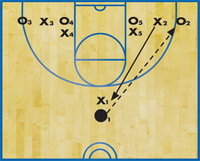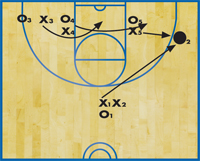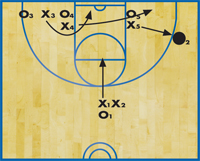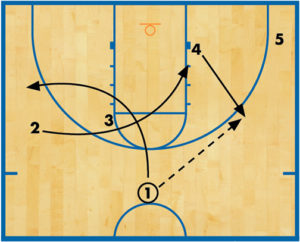Blocking the buzzer beaters: Defensive schemes vs. a 1-4 low set
The 1-4 low offensive set is embraced by teams when the clock is running out. Rather than putting yourself at the mercy of an opponent who is an explosive 1-on-1 player, you should instead play aggressive defensively and force another player to hit a shot.
Remember that in this situation, you’re playing defense with a short clock. Even if the traps create defensive mismatches in the opponent’s favor, the offense won’t have enough time to reset and attack it.

DIAGRAM 1: Trap the ball handler on top. Trapping O1 (in this case by bringing X2) encourages him or her to pass the ball to the player that’s left unguarded (O2).

DIAGRAM 2: Defensive rotations. Since X2 has momentum going away from the ball, you should send X1 to trap the first pass with X5 (who is popping out from the ball-side low post).
X4 slides across the lane to cover O5. X3 drops into the lane area from the backside and protects the middle of the lane. X3 keeps an eye on O4 and O3 on the backside. X2 stays up top and guards O1, contesting any ball reversals.
Since O2 is trapped, he or she has a difficult time seeing O3 and O4. This makes it difficult and risky to throw a cross-court skip pass.
On a pass from the trap, X1 is the defender who must sprint out of the trap and find the next opponent to guard.
Safe trap option
Here’s another trapping option that’s a slightly safer way to accomplish the same defensive goals.

DIAGRAM 3: The defenders are positioned in the same manner as before, guarding the 1-4 low set. X2 breaks hard and springs the double-team trap on the ball handler (O1).
Once O1 is double-teamed, the best option for them is to pass to the unguarded player.

DIAGRAM 4: X5 leaves his or her assigned opponent to cover the player with the ball (O2). X4 breaks over and fronts O5 on the ball-side low post. X3 drops into the lane to cover the backside post.
Since the momentum of X2 is away from the ball, he or she remains on O1. X1 drops off and into help in the lane. X1 is manned up with O3 and watches for any skip passes.
Since there is no secondary trap coming in this option, X1 and X2 must try to force the turnover or disrupt the offense’s called play out of the initial double-team.












